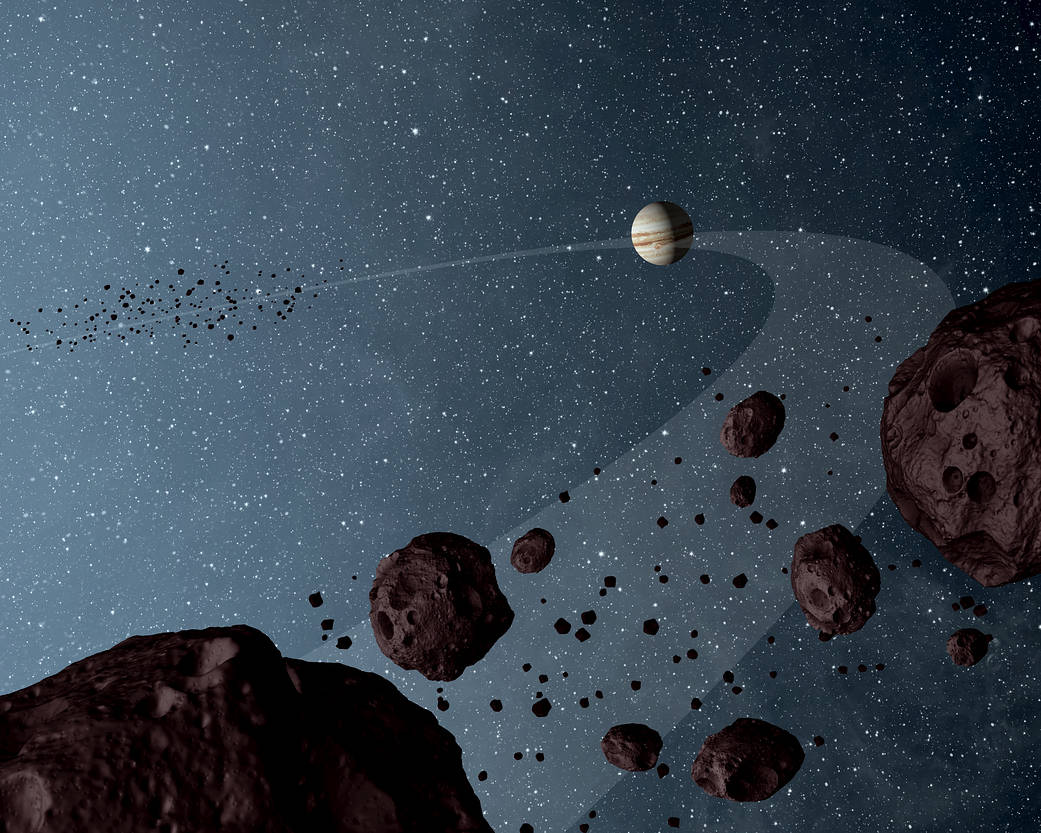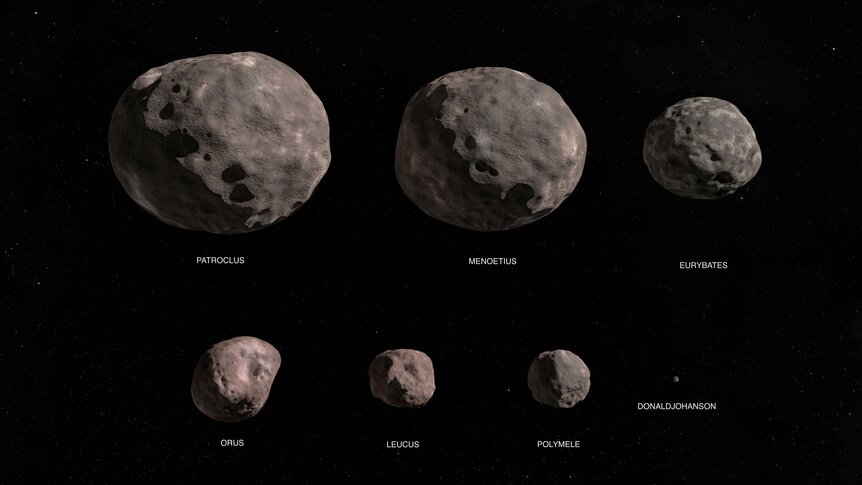Create a free profile to get unlimited access to exclusive videos, sweepstakes, and more!
The Trojan asteroids are prehistoric planetary bones unlike any we've seen before
NASA’s Lucy mission will explore some ancient cosmic fossils known as the Trojan asteroids

When NASA’s Lucy mission took to the sky (SYFY WIRE was there to see it), it was both venturing out to a new frontier for space exploration and echoing an ode to an extremely old skeleton.
Back in 1974, paleoanthropologist Donald Johanson went exploring in Ethiopia and eyed a fossil that would forever change how we saw those who came before us. The 3.18 million-year-old bone belonged to a nearly complete skeleton, which proved ancestral hominids were walking much earlier than we thought. She was later named Lucy after a night of playing the Beatles song Lucy in the Sky With Diamonds on repeat.
Johanson later had an asteroid named after him, and the namesake of NASA’s latest mission to launch into space was the skeleton he discovered — for a reason. Lucy is headed to the swarms of Trojan asteroids that orbit ahead of and behind Jupiter. The bones of the the Lucy skeleton revealed how we came to be human. This mission is looking far beyond even that. The Trojans, which are thought to be up to 4 billion years old, could change what we think we know about the formation of the solar system that spawned us.
Lucy Principal Investigator Hal Levison has been waiting for this almost as long as he can remember. Though Lucy will not reach the Trojans until 2027, it is worth the wait.
“What we’re trying to do is tell the story of human history,” Levison told SYFY WIRE. “That’s always been my passion — to figure out where we came from. By investigating galaxy formation and solar system formation, we are trying to see what made Earth into Earth and how we came out of it.”
Lucy will perform flybys of a record eight asteroids, including Donaldjohanson, the main belt asteroid it will pass before soaring into the Trojans. The Donaldjohnason flyby will assure Earthbound scientists on the Lucy team that the spacecraft is capable of timing everything and focusing its instruments correctly to gather as much data as possible during the narrow window of time it will have to get a closer view of each Trojan. These asteroids are so distant and faint that even Hubble had to proverbially squint to just barely make out any of them.
What is especially interesting about Donaldjohnason is that it is only 100 million years old, one of the youngest surfaces in the solar system as opposed to a spacecraft named for one of the oldest known hominid skeletons. It belongs to the Erigone family of asteroids, which all have similar orbits and spectra because they are thought to have broken off from one parent body. After Lucy whizzes by Donaldjohnason, it will eventually pass Trojan asteroids Eurybates, Polymele, Leucus, and Orus until (after a final gravity assist from Earth) it reaches one of its most anticipated targets in 2033: the binary system of Patroclus and Menoeitius.
“Nobody has come up with a good idea how the binaries were made after the solar system formed,” said Levison. “The Patroclus binary may be a remnant of an early population originally from a region of the Kuiper belt that has not been perturbed by planetary formation. It’s a glimpse far back in time you can see.”
Levison suspects that Patroclus and Menoetius, named for characters from the legendary Trojan War like the rest of the Trojan asteroids, probably landed in Jupiter’s orbit after a series of gravitational interactions pushed and shoved them to where they currently are. He also believes it is possible that many of the objects in the Trojan swarms originated in the Kuiper belt or even in the Oort cloud, the mysterious junkyard of planetary formation leftovers that now wander at the edge of the solar system. Demystifying the Trojans could therefore tell us what strange objects might be lurking so far out and how they came into being.
"I am especially eager to learn more about the Patroclus-Menoetius binary," Lucy Program Scientist Tom Statler told SYFY WIRE. "Two similar bodies orbiting around a common center of mass halfway between them is something we've all imagined but never seen up close."
The ices and craters found on the Trojans could be giveaways for where in the solar system they came from. In the nascent solar system, where everything was being flung around, objects that originally formed in many different regions could have been thrown in with the Trojans. What is found in a fresh crater (“fresh” meaning under 100 million years old) might indicate where an object was born, if you ask Lucy Deputy Principal Investigator Cathy Olkin.
“If you see ices on the surface, different types such as water and methane are really only stable much further out in the solar system than where the Trojans are at now,” she told SYFY WIRE. “Specific ices would be a great indicator that the Trojan asteroids formed further away; density is another such indicator.”
By the way, sorry to anyone hoping for evidence of aliens, but it is unlikely panspermia — the hypothetical spreading of ingredients that may have formed life — happened through the Trojans. They have been floating around where they are for eons and eons because of Jupiter’s gravity, despite the fact that both swarms orbit at quite a distance from Jupiter. Still, Levison anticipates other surprising things about Patroclus and Menoetius that Lucy could beam back.
“The comparison between Patroclus and Menoetius is going to prove or disprove the idea that they formed in the solar system, and any evidence that they are significantly different will probably mean that they formed separately,” he said.
Another factor that could tell us about the formation of the Trojans and the solar system is their color. This is where the attention is really going to be focused on Eurybates and Orus. Though they are similar in size, Eurybates and its satellite Queta are grayish C-type or carbonaceous asteroids, meaning they have a high carbon content (still not a sign of aliens). They are among the few C-types that have been identified in the Trojans, though more than 75% of known asteroids are C-types. You don’t find many gray objects over there. Most are more reddish.
Eurybates is probably a hunk of debris from a rare collision that destroyed a much larger object, which explains why only 7% of Trojans are C-types. Orus is one of the largest Trojans, and a D-type. What exactly makes it red is unknown, and what Lucy will find out about these asteroids is whether the red color is only skin deep. It is possible that the redness of D-type asteroids was caused by some chemical reaction on the surface that C-types like Orus didn’t experience. If that checks out, and the red asteroids are actually gray on the inside, then it could mean some surprise revelations about D-types.
“Eurybates will tell us whether the redness on the red ones is due to surface chemistry, because if that idea is true, that would mean the reds are young,” Levison said. “They probably have organics on them, and some believe that’s what makes them red. Lucy’s near-infrared spectrometer will be able to see that on a flyby.”
Eurybates and Orus were actually the first targets chosen for Lucy because of the comparison opportunity, and Lucy could tell us more about their evolution. The much smaller Polymele and Leucus are also D-types. Patroclus and Menoetius are actually P-types, which, along with the D-types, are thought to be some of the most primitive asteroids with carbon and possibly other organics on their surfaces. Lucy will see them as having featureless red spectra and low albedos. Anything with a low albedo absorbs sunlight rather than bouncing it back into space.
The much broader objective for Lucy is to better understand the formation of the solar system through the Trojans, so it could potentially tell us at least some more fragments of the mystery behind how Earth came to exist. Views on planet formation have changed drastically since Levison began his career. Before, planets were seen as having grown locally and accreted local materials in the protoplanetary disc (formed by the Sun) that the solar system would eventually emerge from. While planets did form by accreting whatever they could, this is now seen as intense competition for resources among gravitational interactions that threatened survival.
“If you want to understand Earth, you need to understand the systems as as whole, even the formations in the outer solar system,” Levison said. “That includes what happened with organics and water came that from the outer solar system, as well as the reason Earth is the size it is. We’re trying to figure out part of that story.”
When the cosmic fossils Lucy is after finally speak, they might blow our minds. Or not. We just don’t know yet.



























